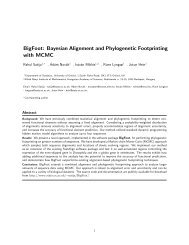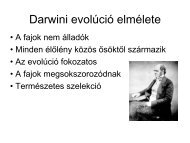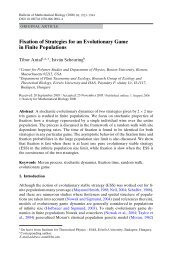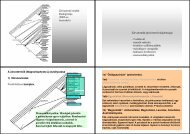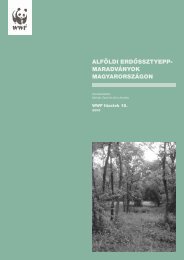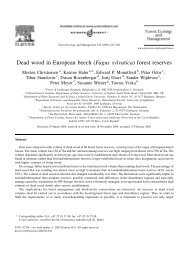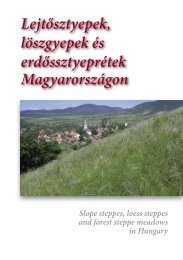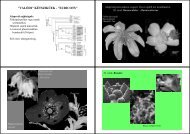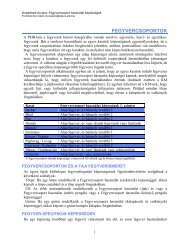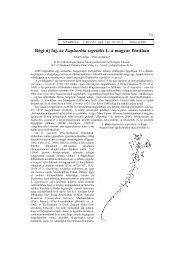Braun-Blanquet's legacy and data analysis in vegetation science
Braun-Blanquet's legacy and data analysis in vegetation science
Braun-Blanquet's legacy and data analysis in vegetation science
Create successful ePaper yourself
Turn your PDF publications into a flip-book with our unique Google optimized e-Paper software.
FORUM<br />
- <strong>Braun</strong>-Blanquet’s <strong>legacy</strong> <strong>and</strong> <strong>data</strong> <strong>analysis</strong> <strong>in</strong> <strong>vegetation</strong> <strong>science</strong> - 115<br />
AD value of 5 is replaced by 87.5%, as commonly<br />
suggested, then the new value will designate all actual<br />
cover values from 75 to 100%, thus <strong>in</strong>creas<strong>in</strong>g uncerta<strong>in</strong>ty<br />
<strong>in</strong> the <strong>data</strong> considerably.<br />
Ord<strong>in</strong>al <strong>data</strong> <strong>analysis</strong><br />
The best <strong>and</strong> mathematically correct solution of the<br />
scale problem is the use of ord<strong>in</strong>ation <strong>and</strong> classification<br />
procedures that are compatible with variables measured<br />
on the ord<strong>in</strong>al scale, that is, the application of ord<strong>in</strong>al<br />
methods of <strong>data</strong> <strong>analysis</strong>. For those not conv<strong>in</strong>ced yet by<br />
the above reason<strong>in</strong>g on <strong>in</strong>admissible arithmetic operations,<br />
I have three further arguments support<strong>in</strong>g the<br />
po<strong>in</strong>t that ord<strong>in</strong>al phytosociological <strong>data</strong> should be treated<br />
<strong>in</strong> a way other than they usually are.<br />
Argument 1: Mean<strong>in</strong>gful dissimilarity<br />
The most critical step <strong>in</strong> select<strong>in</strong>g the appropriate<br />
method is the choice of a dissimilarity coefficient which<br />
is mean<strong>in</strong>gful phytosociologically <strong>and</strong>, at the same time,<br />
compatible with ord<strong>in</strong>al <strong>data</strong>. As an example, let us<br />
consider the follow<strong>in</strong>g artificial phytosociological table<br />
for three relevés <strong>and</strong> two species:<br />
Relevés<br />
h i j<br />
Bromus erectus 1 2 4<br />
Poa bulbosa 2 1 2<br />
If we formally use the well-known Euclidean distance to<br />
measure dissimilarity, we f<strong>in</strong>d that relevés h <strong>and</strong> i are<br />
closest to each other, <strong>and</strong> then follow the pairs ij <strong>and</strong> hj,<br />
more precisely, d hi<br />
< d ij<br />
< d hj<br />
(= 1.41 < 2.23 < 3). It<br />
catches the eye, however, that <strong>in</strong> the most similar relevés<br />
we f<strong>in</strong>d a reverse relationship or ‘negative correlation’<br />
between the two species. Namely, P. bulbosa is more<br />
‘important’ than B. erectus <strong>in</strong> relevé h, whereas it is just<br />
the opposite <strong>in</strong> relevé i. Furthermore, d hi<br />
< d ij<br />
even<br />
though the two species occur <strong>in</strong> the same proportion <strong>in</strong><br />
relevés i <strong>and</strong> j. The conclusion is that Euclidean distance<br />
is mislead<strong>in</strong>g, <strong>and</strong> not only because differences are<br />
calculated between ord<strong>in</strong>al values but also due to its<br />
dim<strong>in</strong>ished ecological <strong>in</strong>terpretability! One could say<br />
that st<strong>and</strong>ardization by relevé totals provides a more<br />
<strong>in</strong>terpretable distance matrix, but this <strong>in</strong>volves addition<br />
<strong>and</strong> division, which is not permissible with such <strong>data</strong>.<br />
We need to f<strong>in</strong>d a coefficient that is compatible with<br />
ord<strong>in</strong>al scores <strong>and</strong> at the same time gives ecologically<br />
<strong>in</strong>terpretable results. The Goodman & Kruskal (1954) γ<br />
coefficient offers the simplest possibility. It counts the<br />
number of species pairs (a) that are identically ordered<br />
by the two relevés be<strong>in</strong>g compared <strong>and</strong> those that are<br />
reversely ordered (b). Then, similarity is def<strong>in</strong>ed as the<br />
ratio γ = (a–b)/(a+b) which yields 1 if all species pairs<br />
are ordered <strong>in</strong> the same way by the two relevés, <strong>and</strong> –1<br />
if the order<strong>in</strong>g is different for all species pairs. The<br />
complement of this coefficient, 1–γ, provides dissimilarities<br />
which are ordered as d ij<br />
< d hi<br />
= d hj<br />
for the<br />
artificial example above. This coefficient, however, does<br />
not use the <strong>in</strong>formation present <strong>in</strong> situations <strong>in</strong> which<br />
AD values are equal <strong>and</strong> therefore order<strong>in</strong>g of species is<br />
not possible for one or both relevés, for example,<br />
Relevés<br />
h i<br />
Carex humilis 2 1<br />
Campanula sibirica 2 0<br />
For an ecologist, this configuration is still <strong>in</strong>formative <strong>in</strong><br />
its presence/absence <strong>in</strong>formation, because these two<br />
species differ between the relevés. As an expansion of γ<br />
to <strong>in</strong>corporate this <strong>in</strong>formation, I suggested the use of a<br />
hybrid discordance measure (Podani 1997) for phytosociological<br />
<strong>data</strong> so that presence/absence still plays a<br />
role <strong>in</strong> calculat<strong>in</strong>g ord<strong>in</strong>al dissimilarity even if order<strong>in</strong>g<br />
is not possible. Accord<strong>in</strong>g to this function, the pair of C.<br />
humilis <strong>and</strong> C. sibirica <strong>in</strong>creases the dissimilarity of the<br />
two relevés. For further examples illustrat<strong>in</strong>g the behaviour<br />
of this coefficient under circumstances not exam<strong>in</strong>ed<br />
above, see App. A <strong>in</strong> Podani (2005).<br />
Argument 2: Overall consistency<br />
There is a def<strong>in</strong>ite direction of <strong>in</strong>formation flow <strong>in</strong><br />
every numerical <strong>vegetation</strong> study, from sampl<strong>in</strong>g through<br />
various steps of <strong>data</strong> <strong>analysis</strong> to display<strong>in</strong>g the f<strong>in</strong>al<br />
diagrams. In this sequence, the quality of the very first<br />
step greatly <strong>in</strong>fluences the subsequent steps, which cannot<br />
give results that are of higher quality than the start<br />
(Gill & Tipper 1978). In phytosociology, this means that<br />
once ord<strong>in</strong>al <strong>data</strong> have been recorded, all steps that<br />
follow should also be ord<strong>in</strong>al <strong>in</strong> nature. The coefficient<br />
chosen should accept ord<strong>in</strong>al <strong>data</strong>, <strong>and</strong> then cluster<strong>in</strong>g<br />
<strong>and</strong> ord<strong>in</strong>ation procedures also should consider only the<br />
order<strong>in</strong>g relationships among the coefficients (Podani<br />
2005). Application of Ward’s cluster<strong>in</strong>g strategy (<strong>in</strong>cremental<br />
sum of squares agglomeration), for example, is<br />
<strong>in</strong>appropriate for ord<strong>in</strong>al <strong>data</strong> because the existence of a<br />
Euclidean space is implied <strong>and</strong> thus the validity of all<br />
arithmetic operations is assumed. Moreover, the method<br />
is much more precise than the precision with which the<br />
<strong>data</strong> were collected. Instead of Ward’s method, a cluster<strong>in</strong>g<br />
procedure is needed which only considers the<br />
order<strong>in</strong>g of ord<strong>in</strong>al dissimilarities. To achieve this goal,<br />
I have suggested a pair of methods, OrdClAn-H for<br />
hierarchical <strong>and</strong> OrdClAn-N for non-hierarchical clas-



